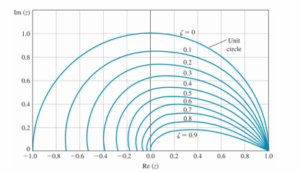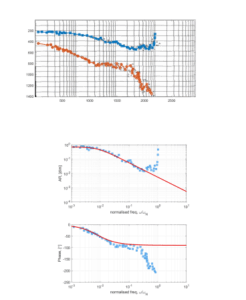| University | Auckland University of Technology (AUT) |
| Subject | ENEL 809 Digital Control |
ENEL 809 Assign 1 in Digital Control with Minor Updates
This assignment is part of the overall course assessment. It has 50 points.
The following general points apply to all work handed in for assessment.
- Hand in your the assignment by the due date through the Canvas portal. You do not need to submit a cover sheet with material that is submitted through the Canvas web portal.
- When including plots and figures, incorporate them in your submission with appropriate axis labels. Always label your plot axes with titles and units. Title your plot.
- When including computer code, use an appropriate font such as courier that clearly distinguishes between the letter l and number 1 (one), the upper case letter O and the number zero, 0, etc. Do not forget meaningful comments in your code.
- You solutions must include all workings to show how you derived the answer. Simply giving the numerical solutions (as is given in the textbook in the drill exercises) is worthless.
- Read the question carefully, and make sure you answer any specific questions. You may need to write a paragraph or two. Often this is more important than your numerical answer.
- Don’t ever print out long lists of numbers. Instead, give me a plot, it saves paper. Be concise.
- Even though it is not always specifically asked for, general comments and a problem critique are always a good thing, in fact they are expected in a professional report.
- Some of these questions are deliberately vague where you are required to make some intelligent and professional decisions regarding issues like colour maps, axis limits and so forth. Make those decisions, and justify them.
Stuck! Do not Know Assessment Answers?
Hire NZ Native Experts 24/7.
Assign 1 in Digital Control
- Scan the completion certificate with your name for the Matlab OnRamp Getting Started course available at:
https://matlabacademy.mathworks.com/details/matlab-onramp/gettingstarted. - Obtain the inverse z-transform of the discrete system
X(z) = z(z + 2)/(z − 1)^2
by:- Using the direct division method, perhaps using deconv.
- Using the computational method by constructing the difference equation, and subjecting that to an impulse. Ensure that your MATLAB code is elegant and efficient.
- By using partial fractions and tables.
- Discuss the advantages and disadvantages of these alternatives solution strategies.
- Note: This question has had minor updates on 28th March, 2025.
We are interested in controlling the plant:
Gp(s) = K / [s(τs + 1)]- What are the units of the complex variable s?
- Find an algebraic expression for the discrete equivalent, G(z) assuming a zeroth order hold.
- Assuming τ = 0.008s and the sample time T = 0.01s, find K so that the overshoot is less than 20% to a unit step change in r(t) when implemented in the closed loop as shown in

Fig. 1. - Determine K to minimise the integral of the squared error.
- Assuming that the system in Eqn. 1 is a speed controller for a brushless electrical motor for a remote controlled lawnmower, what would be a suitable sampling time?
- (a) Write a MATLAB script to produce a plot in the discrete domain of curves of constant shape factor and also overlay curves of constant natural frequency. Make sure you colour your ζ curves red, and your ωn curves green.
You should reproduce something like Fig. 2, but make sure you include the entire unit circle.

Figure 2: Curves of constant shape factor in the z-plane. You will need to reproduce this grid, but include the entire unit circle, and also overlay ωn curves.(b) Overlay on your discrete z−plane diagram (given above in question 4a), the poles and zeros of
G(s) = 2(s + 1)e−2s / [(5s + 1)(s2 + s + 1)]
when sampled at something sensible. Note that this system has some time delay. Make sure your poles are red crosses, and your zeros are blue circles.
Hint: You may want to expand the continuous time system with a Pade approximation. - Fig. 3 shows the experimental frequency response of a diesel engine from [1, p277] and the reference therein. The upper curve is the magnitude response (in dB), and the lower curve is the phase lag (in (negative) degrees). For the purposes of this question, we will assume that the various data points (circles, squares, triangles etc) are all equivalent and from the same engine.By free-hand sketching two curves through the experimental data point cloud, try to approximate a parametric discrete transfer function model for this engine. Do your best to compare your model results as computed with a Bode diagram with the actual experimental data. Comment on how well you fit the data, where the main errors are, and what possibly could account for them.Because a reciprocating engine is naturally periodic, the frequency axis in Fig. 3 is given in normalised units, ω/ωN, where ωN is the Nyquist frequency.
![An experimental frequency response of a diesel engine from [1, p277]](https://www.nzassignmenthelp.com/wp-content/uploads/2025/06/Screenshot-2025-06-09-142239-214x300.png)
Figure 3: An experimental frequency response of a diesel engine from [1, p277]. By sketching two curves, approximately identify a discrete transfer function model for this engine.
Buy Custom Assignment & Homework Solutions
Pay to NZ Native Writers | Cheap Cost & Plag Free
Hints: There are various ways to estimate a transfer function from an experimental frequency response. The following is just one suggest approach, there are others.
- First you need to capture the experimental data points given in Fig. 3.
- You could manually read off the values for each data point, (or a suitable subset), but that is a little tedious,
- so an alternative method is to scan the figure, load it into MATLAB with the
imreadcommand, (as shown in Fig. 4), and then useginputto capture each point. You may need to adjust the scaling from pixel coordinates to actual coordinates. You can then overlay your own data directly onto the figure to make sure you have not made any transcription errors.
- Once you have the experimental (ω, AR) and (ω, Phase) data, you can overlay the Bode diagram of a few trial transfer functions in order to get a reasonable match.Note that the transfer function model shown in Fig. 4 is continuous, whereas the question explicitly asked for a discrete transfer function, hence you may spot some significant differences, especially near the Nyquist frequency.

Figure 4: Scanning the actual figure to capture the data points, and then overlaying trial transfer functions to get a decent match. Note that the overlayed mode is continuous.
- Consider the perfidious continuous time system:
Gc(s) = 1/(s + 1) + π / [(s + 0.02)2 + π2].- 4 pts Convert Gc(s) to a discrete system, Gd(z) with a sampling time of Ts = 2. What order is Gc(s) and what order is Gd(z). Explain your answer. Are there any issues you should be aware of?
- 3 pts Simulate the response of the discrete Gd(z) to a step test, perhaps using step. Is the discrete response oscillatory? Based on the poles of Gc(s) what would you expect the response to be? Explain in detail your answer.
- 3 pts Re-sample the continuous system Gc(s) slightly slower at Ts = 1.8. Plot the step response of the continuous and discrete version. Explain your observations of the results.
References
[1] Karl-Johan Astråm and Björn Wittenmark. Computer-Controlled Systems: Theory and Design. Prentice–Hall, 3 edition, 1997.
In quest for a professional assignment help?
Flexible rates compatible with everyone’s budget
Are you stressed about your Digital Control Analysis for Discrete System Design Using MATLAB? There's no need to worry! We are here to assist and provide high-quality zero-AI Assignment Help NZ of high quality with original content written by our PhD expert writers. Just write do my assignment, and we will make sure your assignment will be completed on time by our university assignment helpers. Also, we have free assignment samples for students, so you can get an idea of the quality. Now, stop worrying about late submissions and contact us for the best grades. Hand over your assignment worries to our experts today!
- LAWS390 Business Law for Māori Organisations Essay | VUW New Zealand
- Nursing Assignment 3 : Factors that Impact Registered Nurses’ Ability to Influence National Government Health Policy
- The Management and Behaviour or Pregnant Sows on Pasture Assignment 1 | Massey University (MU)
- HAS 962 Occupational Hygiene: Measurement Assessment 4 AIOH Technical Report | UOW
- IT00143 Install & Optimize Software Applications Assignment | Pacific Polytech
- Digital Tourism and Hospitality Assignment Report | Auckland University of Technology
- HEAL840 Critical Enquiry for Evidence Based Practice Additional Assessment Opportunity (AAO) Semester 1 2025
- RES903 Research Dissertation Assessment One | Nelson Marlborough Institute of Technology (NMIT)
- 71338 Managing Change Assessment 3 Strategy and Implementation Report | Open Polytechnic
- BSRV4601 Fundamentals Real Estate Assignment 1: Eligibility and licensing | Open Polytechnic (OP)


